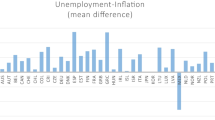Abstract
The introduction of the euro was accompanied by promises of lower inflation rates; however, the public feels that inflation increased when the euro was introduced. Officials admit that certain sectors experienced substantial price increases, but they claim that the overall inflation rate did not increase. This paper investigates whether inflation in 15 European countries experienced a structural break after the euro was introduced using new powerful and serial correlation robust test statistics. We find evidence that the European Monetary Union (EMU) countries experienced a positive break in inflation after 1999. Our results demonstrate that inflation just after the introduction of the euro was higher relative to the inflation just prior to the introduction of the euro. Additionally, we find no evidence of positive breaks for the non-EMU countries when the euro was introduced.
Similar content being viewed by others
References
Adriani F, Marini G, Scaramozzino P (2003) The inflationary consequences of a currency changeover: evidence from the Michelin red guide. CEIS Tor Vergata working paper
Angelini P, Lippi F (2007) Did prices really soar after the euro cash changeover? Evidence from ATM withdrawals. Int J Central Bank 3(4): 1–22
Andrews DWK (1991) Heteroskedasticity and autocorrelation consistent covariance matrix estimation. Econometrica 59(3): 817–858
Andrews DWK (1993) Tests for parameter instability and structural change with unknown change point. Econometrica 61: 821–850
Andrews DWK, Ploberger W (1994) Optimal tests when a nuisance parameter is present only under the alternative. Econometrica 62: 1383–1414
Aucremanne L, Collin M, Stragier T (2007) Assessing the gap between observed and perceived inflation in the euro area: is the credibility of the HICP at stake? National Bank of Belgium working paper no. 112
Bai J (1997) Estimating multiple breaks one at a time. Econ Theory 13: 315–352
Bai J, Perron P (1998) Estimating and testing linear models with multiple structural changes. Econometrica 66: 47–78
Bai J, Perron P (2003) Computation and analysis of multiple structural change models. J Appl Econ 18: 1–22
Breitung J (2002) Nonparametric tests for unit roots and cointegration. J Econom 108: 343–363
Bundesbank (2004) The euro and prices two years on. Deutsche Bundesbank monthly report
Commission of European Communities (2005) Annex to the: second report on the practical preparations for the future enlargement of the euro area. Commission Communication of 04.11.05 COM(2005)545
Dziuda W, Mastrobuoni G (2009) The euro changeover and its effects on price transparency and inflation. J Money Credit Bank 41(1): 101–129
Eurobarometer (2002) The Euro, one year later. European Commission flash EB 139
Eurobarometer (2003) The Euro, two years later. European Commission flash EB 153
Eurobarometer (2005) The Euro, four years after the introduction of the banknotes and coins. European Commission flash EB 175
European Central Bank (2002) Annual report
European Central Bank (2003) Annual report
Feldstein M (1997) The political economy of the European economic and monetary union: political sources of an economic liability. J Econ Perspect 11(4): 23–42
Giavazzi F, Spaventa L(1990) The new EMS. Centre for Economic Policy Research discussion paper no. 369
Gomez V, Maravall A (1996) Program TRAMO-SEATS. Banco de Espana
Harvey DI, Leybourne SJ, Taylor AMR (2008) Simple, robust and powerful tests of the breaking trend hypothesis. Econ Theory (forthcoming)
Hobijn B, Ravenna F, Tambalotti A (2006) Menu costs at work: restaurant prices and the introduction of euro. Q J Econ 121: 1103–1131
Kwiatkowski D, Phillips PCB, Schmidt P, Shin Y (1992) Testing the null hypothesis of stationarity against the alternative of a unit root: how sure are we that economic time series have a unit root? J Econom 54: 159–178
Lopez C, Papell DH (2007) Convergence to purchasing power parity at the commencement of the euro. Rev Int Econ 15: 1–16
Newey WK, West KD (1994) Automatic lag selection in covariance matrix estimation. Rev Econ Stud 61(4): 631–653
Park JY (1990) Testing for unit roots and cointegration by variable addition. In: Fomby T, Rhodes F(eds) Advances in Econometrics: Cointegration, Spurious Regressions and Unit Root. JAI Press, London, pp 107–134
Park JY, Choi B (1988) A new approach to testing for a unit root. CAE working paper no. 88-23, Cornell University
Sayginsoy O, Vogelsang TJ (2007) Testing for a shift in trend at an unknown date: a fixed-b analysis of heteroskedasticity autocorrelation robust OLS based tests. University at Albany working paper
Vogelsang TJ (1998) Trend function hypothesis testing in the presence of serial correlation. Econometrica 65: 123–148
Author information
Authors and Affiliations
Corresponding author
Additional information
The author would like to thank Betty C. Daniel, Ozgen Sayginsoy and three anonymous referees for their helpful comments and suggestions.
Rights and permissions
About this article
Cite this article
Shiamptanis, C. Did the euro give us a break in inflation?. Empir Econ 39, 395–411 (2010). https://doi.org/10.1007/s00181-009-0309-3
Received:
Accepted:
Published:
Issue Date:
DOI: https://doi.org/10.1007/s00181-009-0309-3




